Tripawd dogs don’t have a spare leg to lose. When Ziggy needed a canine limb difference correction surgery, nobody really knew how well he would recover. If another leg surgery on a Tripawd is necessary, things can get scary. But Ziggy showed that Tripawds are capable of so much more than we think!
Ziggy recovers from canine limb difference correction surgery on remaining front leg
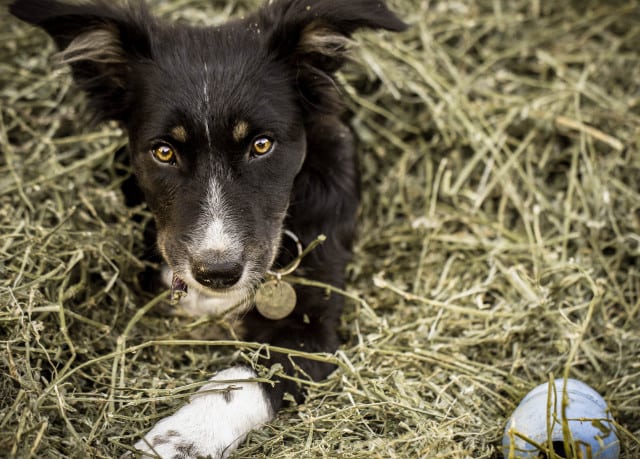
Less than a decade ago, orthopedic vet surgeons would have nixed the idea of a major limb surgery like a TPLO, FHO or hip replacement on an amputee animal. But technology has improved dramatically and now a Tripawd has just as good a shot at recovering as four-legged animals.
As those who’ve been through it can tell you, recovery isn’t easy for a Tripawd, but it’s not impossible either. Ziggy and his people Rebecca Colvin and Glenn Althor are proof that Tripawds are quite capable of recovering after another leg surgery.
A Remarkable High-Tech Angular Limb Difference Surgery on a Tripawd
Ziggy has been a member since 2014 when he was a wee lad. Rebecca and Glenn adopted him from the Australian rescue organization the RSPCA in Brisbane. In an interview with the University of Queensland’s News team, they said:
“He was a happy little puppy and didn’t mind at all that he only had three legs,” Rebecca said.
“However, a few months later we started to notice that he wasn’t walking well. He was limping, and seemed to be in pain.”
“Our local vet referred us to the referral surgical service at the UQ VETS Small Animal Hospital in Gatton, where it was explained that Ziggy had an angular limb deformity as a result of damage to the growth plates in his front leg.” — Read more.
Ziggy’s pack spent the next two years working with university vet experts to save that leg. Without it, Ziggy’s future was uncertain. Many of you may recall his ongoing, sometimes heartbreaking struggles in his Tripawds blog. If you wondered why the blog disappeared, it’s because when Rebecca and Glenn turned to the vet surgeon experts at the University of Queensland, they had to go stealth on his situation because of proprietary technology the vet school would use to save his leg.
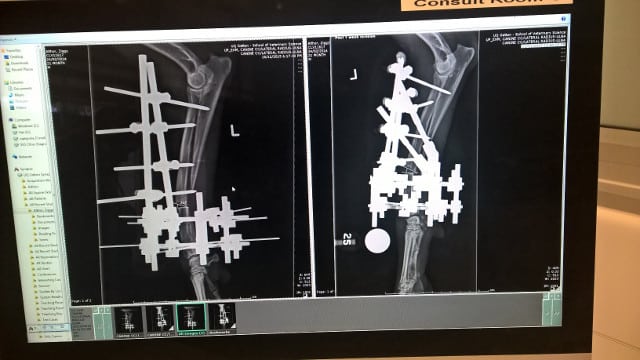
Over one year after Rebecca and Glenn sought help for Ziggy, the amazing University of Queensland, Australia vet team finally made it official: Ziggy’s high tech angular limb difference corrective surgery is a success! In the university’s article, “Three-legged Ziggy Back on His Paws” vets describe how they used 3D printing to carefully determine how to correct and manipulate his leg bone so Ziggy could have a normal life on three legs. After surgery Ziggy and his pack had a long, ten week recovery that included a fixator worn 24/7 on Ziggy’s leg to keep the bones healing together, a front-leg dog cart and a trusty Webmaster harness.
Knowing that Ziggy’s story will give hope to others in similar situations, Rebecca and Glenn generously shared Ziggy’s recovery experience with us in this Q&A interview. We hope you find their unedited interview as hopeful and fascinating as we do!
Q: How is Ziggy doing now? What kind of differences in his personality and stamina are you seeing?
Ziggy is going well, thank you! Now that the fixator is off, Ziggy’s leg is safely bandaged up with a splint so that his bones can continue healing – and are protected while they do so. It took a few days for him to adjust to the change in his mobility, and while he’s still a bit slow around the house, he is comfortable and happy.
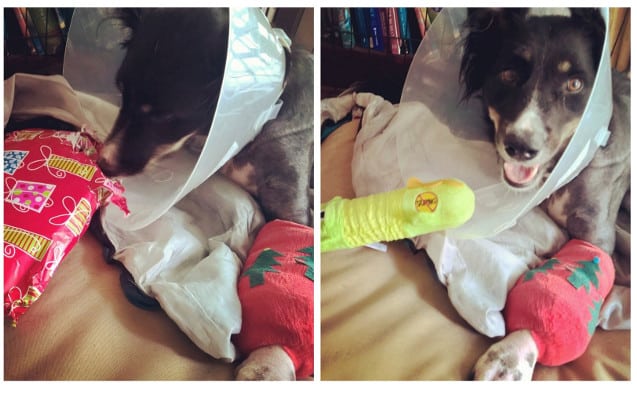
During his time with the fixator on, his stamina certainly started off very low when he was sore and clearly felt vulnerable (he needed LOTS of cuddles), but he just kept getting better and stronger every day. Now that the fixator is off, though his recovery is still progressing really well, his mobility has taken a bit of a step backwards. This is because the fixator had been taking much of the strain while he was walking, but now with it off that weight is going onto his leg and his newly corrected bone. The splint is there to help and protect, but this next phase of his recovery will take some time, too.
The biggest change in his behaviour is likely to still be ahead of us, when the bandage and splint come off and he regains strength in his leg. We’re thankful that he has never stopped being the loving, friendly, and happy little critter throughout everything he has been through.
In the beginning, what went through your head when Ziggy’s leg wasn’t getting any better? How did you find it within yourselves to investigate Ziggy’s options? Did you think there were any options? Was the investigation part overwhelming?
This was very overwhelming! Zig’s troubles started when he was only 6 months old, and when he had been in our family for only 3 months. He was still a puppy, and we were first-time dog-parents. We were lucky, more than anything else, to have been referred onto the most wonderful person at the university vet hospital – although Glenn and I were devastated that Zig’s life wasn’t going to be as happy and carefree as we hoped, we all ended up in the best possible hands.
Perhaps unlike the experience many other people have where they need to seek multiple opinions and do their own research, we were able to defer to the expertise of Zig’s surgeon at all times. So we were very fortunate in that we didn’t have to do our own investigation into what Ziggy needed, as Zig’s surgeon kept us very well informed and explained everything – from how the issue came about to the risks, uncertainties, and prospects for his surgery and recovery.
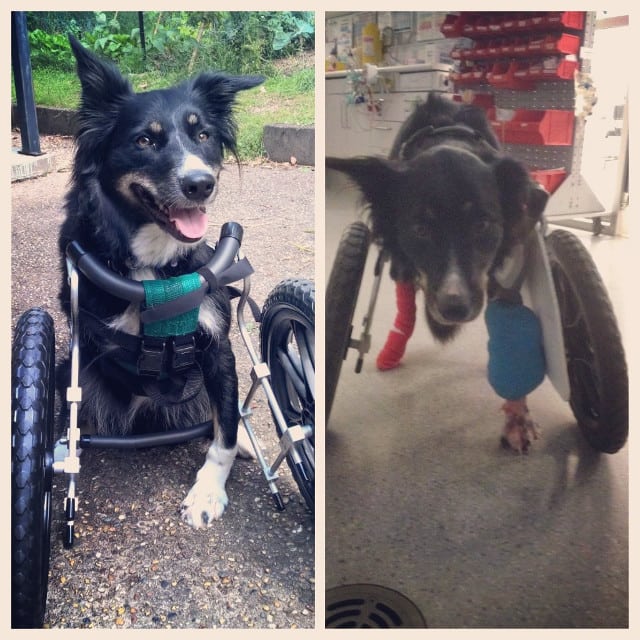
One of the hardest things, from a personal perspective, was the uncertainty. When Zig’s trouble was identified as an angular limb deformity (on his only front leg!) there was no way to tell whether he would be okay after the first (less-significant) surgery in September 2014, or if he would need major surgery later on (which he did – the corrective surgery in December 2015). Although we never questioned that we wanted to go through with whatever was required to make Ziggy okay, in the early days we did have to think about the possibility that if he couldn’t use his front leg, then we wouldn’t have the capacity to care for him (if he needed someone with him at all times), and that we may have needed to find a new family for him. This was just heartbreaking (and the thought of it still breaks my heart now!), but thankfully he has been looked after so well by the vet hospital, and his recovery is on track, so this isn’t something we need to worry about any more. But at the time, it seemed like an impossible possibility – something we had to consider but was terrifying and devastating.
When the UA vets told you they were considering a corrective limb difference surgery, what did you and Glenn think? Did you ever have doubts? How did you remain positive?
Ziggy’s first surgery (an ostectomy) happened within days of our first consult at the vet hospital. This was because of the nature of the angular limb deformity – as he was a growing puppy the surgery had to happen ASAP in order to stop it from getting worse. At this point, it was probably a good thing that it all moved so quickly! Although those early days were very sad and scary, we didn’t have time to worry about the ‘what if’ questions – we were just straight into it. The first few weeks after his first surgery were the hardest, because at this stage his mobility was very limited, he needed a lot of help (he still had a puppy’s bladder!), and at that point we didn’t have the experience to know that “it just gets better” with time.
For a little while there, I was not feeling very positive at all. It was hard, but it just got easier as Zig got better. During the weeks after his ostectomy, we were also hoping that this would ‘fix’ his leg, and that he wouldn’t need the corrective surgery. While the ostectomy was very successful in that it did what it was meant to do – to stop the deformity from getting worse as Ziggy grew – the corrective surgery was necessary in order to make sure that his prospects were good for the long term.
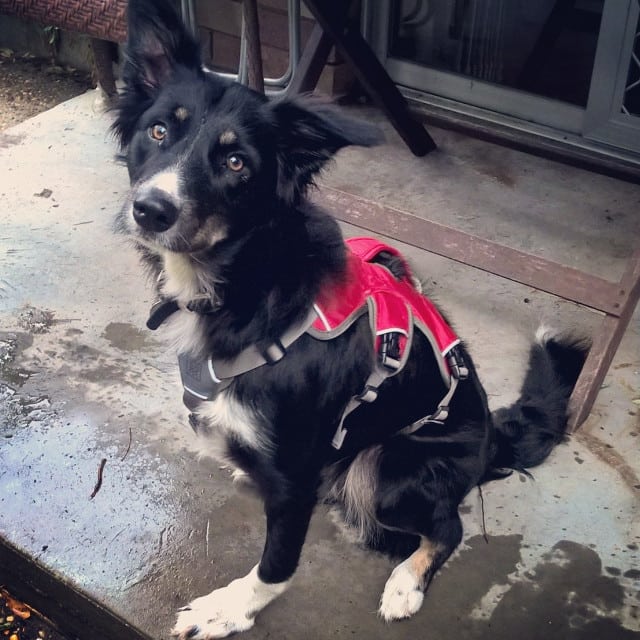
In between the ostectomy and the corrective surgery, Zig had a relatively normal life for a while where we could go for neighbourhood walks, and Zig was able to stay at home on his own. We were always cautious about his limitations, but it did seem for a while as if we could pretend that he wouldn’t need the corrective surgery! But he did, and when the time was right for that to happen, we just had to accept it and be thankful that he was being looked after by a person we trusted, who is very capable, and who also loves Ziggy. So our luxury at this time was having was complete trust in Ziggy’s surgeon and knowing that she knew what is best for him, but even so, it was still sad to see him being happy and mobile (despite his wonky leg) knowing that he would have some rough months ahead.
After his corrective surgery, we were astounded by how quickly he gained strength. It was an almost entirely different post-surgery experience compared to the ostectomy! I think the knowledge that “it just gets better” really carried us through. We also knew that this surgery is likely to be the last major surgery (aside from possible additional surgeries much further down the line), so we also did not have the fear that there was something scary looming in the future.
Ziggy leaving the hospital, December 2015
Zig was what kept us positive throughout the two surgeries, his recoveries, and the time in between. Even during the tough times, when we would be sad or scared for him, he would still manage to be so loving and sweet, and without trying would make us smile. His gentle and loving nature would make us happy, and his silliness would make us laugh, despite everything else going on! We also had the great benefit of knowing that no matter what might happen, we could always count on his surgeon to look after him. So we had a lot of confidence in his surgery and care, and knew that if we could depend on her if we were ever concerned about anything.
What kind of wheels does Ziggy have? Will he always need it? If so, how often does he use it?
Ziggy’s cart! We have a front-wheel cart from Eddie’s Wheels. It has been the most wonderful boon to his recovery. We bought the cart some time after his ostectomy, but ahead of his corrective surgery. The idea was to get him adjusted to using it before his corrective surgery so we could just buckle him in afterwards to maximise the quality of his life during his recovery, especially for toileting. Zig’s surgeon, again, helped us with the decision-making and with taking all the measurements for Zig (and she also managed to make the magic adjustments which really got him going well in his cart), so we were very lucky to have her guidance and wisdom in everything.
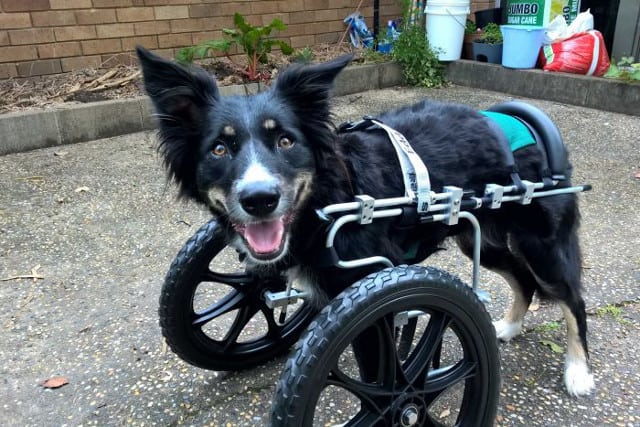
It did take some time to get the adjustments right, but the folks at Eddie’s Wheels were great in that they were quick to reply to my questions over email and offer suggestions for how the cart could be adjusted.
Unfortunately, Zig didn’t take to doing his business while in the cart, so the plan to be able to put him in the cart for that didn’t quite work out. But that aside, he absolutely LOVES using his cart. He can run with his head held high in the air (rather than bouncing around as he was used to), and when he is starting to be a bit over-excited or energetic, we can go for a little walk or run in the cart to expel his energy so he can then relax. He has had a few tumbles, but has never been injured, and he just lays patiently in his cart until he has been lifted back up the right way.
These days, he seems satisfied with a cart-expedition every couple of days. When he was at the peak of his mobility with the fixator on, he would sometimes need 2 cart-walks per day! I imagine that as he keeps getting better, he will want more and more time in his cart.
All going well for Zig’s recovery (which is the case so far!), he should not require the cart in the long term. But at least for now, we are so pleased to have it, as it means he can exercise without risking damage to his precious leg. We also think that in the longer-term it may be a nice option for going on longer walks with Ziggy when he might otherwise get a bit too tired. The great thing is that it is adjustable, so once his splint and bandage are off, we’ll be able to make adjustments to the cart so he is able to take some gentle weight on his front leg while still carrying most of his weight on the cart.
Will Ziggy need rehab therapy? If so, how much and for about how long? What kind of limitations are placed on his activity?
Zig will need some physiotherapy-type work once the splint and bandage are off, though we don’t know the details yet. After the ostectomy, Zig’s surgeon demonstrated some stretching for us to do on Zig’s leg, and he went really well with that. We’ll be following the lead, as always, of Zig’s surgeon with what will happen there – and will be pleased to tell you more when we know more!
What words of wisdom do you have for other Tripawd parents facing a remaining leg surgery?
Wow, well most definitely knowing that things get better. After Zig’s surgeries, his toileting habits were disrupted significantly – to the point where he might do just one wee per day, and he seemed to be constipated for a while too. This was hard, as we wanted to make sure he didn’t have an ‘accident’ which would wet his bandage and risk infection on his leg, or cause him discomfort or any other problems.
But because he wasn’t able to take weight on his leg, this meant we had to carry his weight using a harness while he walked on his back feet, with his front leg dangling in front of him! It was very trying, particularly when Zig would make little sad sounds and we didn’t know whether this was asking to do a wee, or wanting a cuddle, or a sign of pain. But really – each day got easier, and each check-up at the hospital was good news.
After a little while his toileting habits returned to a normal routine, and a little while later his leg became stronger and he started walking on his own. Although it was tough at times, it really did just get better!
Other equipment to help Ziggy after canine limb difference surgery
The other thing which really helped was having great equipment to support Zig’s recovery. At home, we were so glad to have a Ruffwear harness. This was a massive help when we were taking his weight while he was going to the toilet (a bit help for our backs), and it was also really great for around the house as the handle on the back meant that we could grab him quickly if it looked like he was likely to hurt himself.
Now, he wears it in the car with the seat belt, he wears it in the cart so we can clip a lead to the middle of his back (to avoid toppling him by accidentally pulling him off balance!), and he has come to associate it with fun adventures, so is always excited to put it on. From the hospital, Zig’s surgeon also gave us sleeves from used gowns. These are made of splash-proof fabric, and we can just pull them straight over his bandage and hold them in place with elastic bands. It’s a really great solution for keeping the bandage clean and dry, especially during toilet trips.
We have a great pen for Ziggy, and his confinement area was set up next to a window at the front of the house from where he could watch the other resident animals – the chooks. We also had a baby gate set up in our bedroom around Ziggy’s bed so that he could always be with us in a nice space to keep him safe. The cart, of course, has been great too.
Significantly, having supportive people around us has made a world of difference. You at Tripawds who have always cared about Ziggy and us, Zig’s wonderful surgeon whom we trust, and caring friends and family really helped us through the tricky times. Having a support network where you can ask questions and listening to others’ experiences (especially the happy-ending stories) really is priceless!
And perhaps most importantly – seeing Ziggy wag his tail, or go cross-eyed while staring at a treat, or wriggle all over with joy from seeing a friend – these are the things which can give so much happiness and serve as reminders for why the hard days are worth it!
(Photos and videos courtesy of Rebecca Colvin, Glenn Althor and the University of Queensland’s Veterinary Medical Centre)
More Examples of Tripawds Who Recovered from Remaining Leg Surgeries
Tripawd Tuesday: Murphy’s Miraculous Milestone
When a Tripawd Needs Another Leg Surgery
Dog Rehab Therapy Helps Tripawds Beat the Odds
Tripawd Max Does Swimmingly Well, Even After Hip Replacements
Bionic Ajax is home and hopping around…
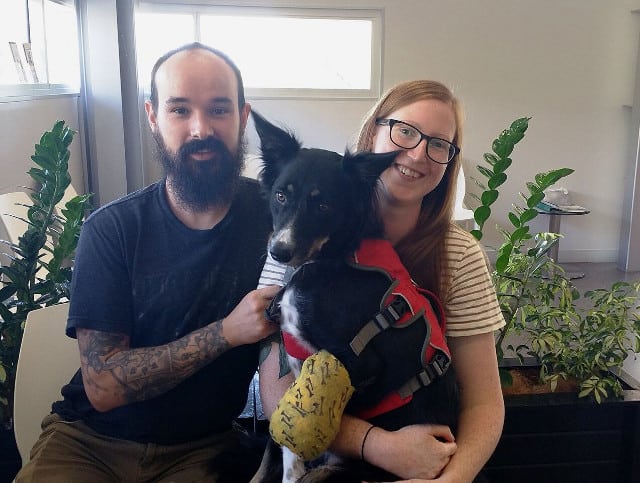
This post is late but I’m hoping for some input. Our pup also has angular limb deformity in his front legs and we just got a great cart from Eddie’s Wheels a few days ago. I see Ziggy is using his like a champ.
Any tips on how you got Ziggy to accept the cart and feel comfortable using it? We’re using lots of treats and praise but our dog keeps trying to jump out. I’m sure it’s only a matter of time but would appreciate any advice.
Please consult with a certified canine rehab vet/tech for proper introduction to a wheelchair and the best training tips. See the various posts about wheelchairs for Tripawds for much more information.
Thanks very much. We’ll follow up.
It has been such a privilege to follow Ziggy.s moirney here o. TRIPAWDS!
He, and his pawrents, are such an outstanding inspiration! The devotion that have for Ziggy…The trust Ziggy has in them…pure magic!
Looking forward to celebrating more victorious milestones of this amazing pack!
Love!
Sally and Alumni Happy Hannah and Merry Myrtle and Frankie too!